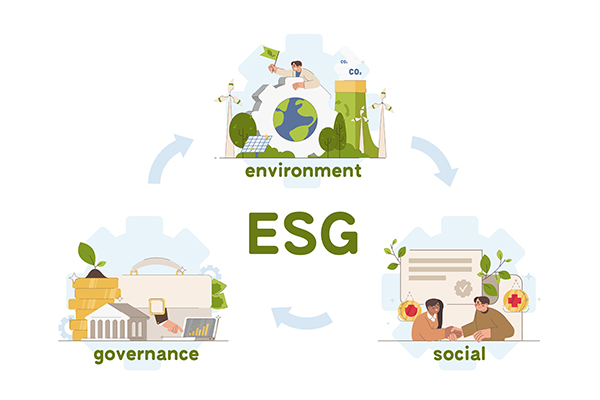
Environmental, Social, and Governance (ESG) standards are becoming increasingly important in today's corporate environment. Companies are increasingly judged on their sustainability, ethics, and corporate responsibility. Adopting LED lighting can significantly advance your ESG goals while delivering economic benefits. Here’s how LED lighting can propel your company toward its environmental objectives, enhance operational efficiency, and improve overall workplace well-being.
Environmental Impact
Energy Efficient
LED lamps are highly energy-efficient; they use at least 75% less energy than traditional equivalents such as incandescent bulbs, and last up to 25 times longer. As a result, they help save money spent on electricity due to reduced greenhouse gas emissions. For according to CNBC News, Walmart changed its 6k stores from conventional lighting to LEDs and saved approximately $200m annually.
High Conversion Efficacy
High conversion efficacy means lower power bills, as most LED fixtures convert about 90% of energy consumed into light and reduce the carbon footprint related to this source more than any other means.
Hazard-free and Recyclable
In contrast to traditional lights, LEDs do not contain harmful compounds such as mercury. They can also be produced in accordance with circular economy concepts, as their components can be reused once their life cycle is complete. For example, IKIO implements lean practices in manufacturing luminaires that can be recycled and reused.
Social Benefits
Improved Lighting Quality
LED lighting offers brighter and more uniform light, reducing eye fatigue and headaches that can negatively affect workers. Research suggests that better illumination enhances employee performance and reduces errors and accidents immensely.
Customizable Work Environments
The range of LED light intensities and color temperatures can be adjusted to accommodate various types of tasks or time periods during the day. Warmer colors help achieve a sense of coziness in space, whereas cooler shades contribute to increased vitality levels and better concentration.
Governance
Smart Control Systems
Smart LED lights comprise advanced features such as motion detectors, settable parameters, etc. that allow energy conservation and mindful usage. This technology also provides valuable data for compliance demonstration and governance reporting.
Enhancing Transparency
Smart control systems gather data that helps businesses comply with regulations and improve transparency in their ESG reports. These systems also track energy efficiency. This data is beneficial for investors looking for sustainable properties and aiming to enhance the experience for building occupants.
Approach to Implementing LED Lighting Strategies
Conduct an Energy Audit
Begin with your current lights to identify areas where there is energy wastage. This will help you create a road plan for converting to LED lighting while considering potential savings and other benefits.
Use of Financial Incentives
Environmental incentives at the federal, state, and municipal levels help pay for green projects. The cost of purchasing LED technology can be claimed back through the Federal Investment Tax Credit. Many states have rebates in place that cover a significant portion of the expenses, making migration economically feasible.
Use Smart Technology
Incorporate smart LED solutions that allow for automated lighting control. This may include things like presence detectors, daylight harvesting, and programmable settings as an enhancement on energy use optimization. For example, intelligent lighting at San Diego International Airport cut down energy consumption by 25%, saving around $800,000 a year (Fortune Business Insights).
As a prominent provider of LED lighting solutions and a recognized Minority Business Enterprise (MBE), IKIO stands at the forefront of sustainable business practices. Our range of LED lights, including Shoebox Lights, Linear Low Bays, Troffers, and Backlit Panels, are designed for superior energy efficiency and conversion efficacy. This results in significant energy savings and a reduced carbon footprint. Moreover, these lights comply with both BAA and BABA standards, further emphasizing IKIO’s commitment to sustainability.
Conclusion
Transitioning to LED lighting is a strategic move that aligns with the growing emphasis on ESG criteria. The reductions in power expenses, lower repair expenditure rates, increased workplace efficiency, and a positive business image all contribute to a strong return on investment (ROI). By integrating LED technology, your company can lead the way in sustainable business practices, ensuring long-term environmental and economic benefits.
FAQs About LED Lighting and ESG Integration
How does the adoption of LED lights help achieve ESG goals?
LED lighting helps to reach ESG standards by reducing energy consumption and greenhouse gas emissions. The lights also make working environments more conducive leading to better health and productivity levels among employees.
Are there any financial incentives for businesses to switch to LED lighting?
Businesses switching from regular bulbs to LEDs can benefit from different federal, state, and regional incentives. These include such programs as the Federal Investment Tax Credit (ITC) and various state rebates, which greatly reduce the initial price of LED technology upgrades.
How can smart LED lighting systems enhance operational efficiency?
Smart LED lighting systems increase operational efficiency by integrating features such as motion sensors, daylight harvesting and programmable settings that optimize energy consumption in real time, thereby cutting waste and reducing the costs of power usage.
What are the health benefits of using LED lights in offices?
LED’s provide adjustable light intensity and color temperature, hence making the environment more comfortable for different tasks in a day or even allowing changes.
What are the environmental benefits of LED lighting compared to traditional lighting systems?
LED bulbs use less energy, and have longer lifespans unlike incandescent bulbs hence they consume less overall energy resulting in low waste. It is also important to note that these lamps are mercury-free, thus environmentally friendly and easy to recycle, fitting into circular economy principles.